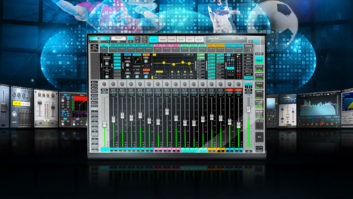Since the dawn of time, humans have recorded location audio on analog Nagra recorders. Along the way, brave individuals have made forays into other formats, ranging from Sony PCM-F1s to timecode DAT decks to the awesome-yet pricey-Nagra-D. And although all of these formats offer the advantages of digital recording, all are tape-based and subject to the inherent drawbacks of tape, such as lack of random access and the lengthy time required to transfer takes into digital audio workstations. Meanwhile, a number of companies have offered disk-based field recorders, but these typically lacked timecode capability, were designed more for radio production and employed data compression to keep file sizes manageable.
However, another solution was on the horizon: The Zaxcom Audio Deva (pronounced like “diva”), a compact, 4-channel disk recorder, was first unveiled at AES in 1996. Timecode-capable, DC-powered and lightweight, Deva seemed ideally suited for location audio and offered 20-bit uncompressed recording/playback. Unfortunately, the early Devas weren’t exactly ready for prime time (literally), and Mix contributor Larry Blake was among those who suffered through the pangs of early software versions, experiencing maddening bugs and system crashes. A few years later, we decided to take another look at Deva and found that time-and several software revisions (it’s now at V.5.03)-can make an enormous difference in a product.
Housed in a cigar box-sized (8x3x7-inch, WxHxD) aluminum chassis, Deva features simultaneous 4-channel record/mix capability, timecode and RS-422 control, four track-hours of recording time per disk (removable 2.2GB drive), simultaneous recording to onboard drive and/or external SCSI device (such as a Jaz drive), backup streaming to optional recordable DVD drive, XLR mic inputs, software-selectable highpass filters (30 to 220 Hz in 10Hz steps), onboard mix capability and backlit LCD status/metering readout. The 4-channel version is priced at $9,995- including 2.2GB removable drive, timecode option, battery, charger, 12 VAC supply and all necessary cabling.
Each of the mic preamp inputs has a switch for selecting 48VDC phantom power, as well as recessed trim pots for optimizing inputs to match mic sensitivity. A monitor mode switch selects/ routes a number of headphone combinations (track 1-2 stereo, 3-4 stereo, 1-2 left/3-4 right, 1-2-3-4 summed mono, 1-2 mono, 3-4 mono or track 1/2/3/4 individually to mono). Speaking of headphones, the built-in headphone amp is clean and loud. Deva offers three-way powering (100-240 VAC, 12 VDC external or internal battery), with the latter being an NP-1 type providing two hours of operation. With the proliferation of NP-1 batteries in the industry, Zaxcom’s choice of this cell is a good one. The unit’s external DC input is a 4-pin Lemo type-a rugged quality connector, but not quite as universal as the standard 4-pin XLR connector used on Cine-60 belts and many other 12 VDC-powered film/video devices. To use such supplies, a simple XLR-to-Lemo cable could easily be fabricated, or perhaps Zaxcom could offer this as an option in the future.
Beyond its location features, Deva supports 48kHz and 48.048/ 47.952kHz pull up/down sampling frequencies (32 or 44.1 kHz is not offered), +4dB balanced analog line inputs/outputs via an XLR-to-DB25 fan-out cable, AES/EBU I/O (also on an XLR fan-out cable), SCSI port for direct to workstation/backup media connections, RS-422 Sony P2 control with BVW-70 emulation, and the ability to read/generate/chase to incoming timecode at 24/25/29.97DF/29.97 NDF/30 DF/30 NDF frame rates.
Deva’s user interface is fairly simple to master, but it requires a bit of getting used to. Most functions and settings are via a number of menus. You either press one of the front panel buttons directly or merely press a centrally located Shift key in conjunction with one of the dual-function buttons. Generally, these operations are carried out much faster than it takes to describe them. For example, pushing Shift and the number 9 on the keypad enables Fader Control (we know this because those words are written in white silkscreen above the 9), which allows the user to quickly route any mic input(s) to any record track(s). If you want to feed track 2 from a mix of faders 1/3/4, the entire procedure takes less than five seconds; and other functions-such as sending a 1kHz tone to all tracks, selecting timecode/ sampling rates, headphone modes, etc.-are just as fast. Zaxcom touts Deva as a recorder/mixer, which it certainly is, especially when using the four input pots to create mixes. However, the unit’s ability to create output mixes from recorded disk tracks using setup screen commands (a useful tool in field production) is better suited for static mixes than for complex on-the-fly mix movements.
In the field, Deva balances nicely on a shoulder strap (not included), and its light 5-pound total weight will be appreciated by those who use other location recorders that are powered by more than Deva’s weight in “D” cells alone! The LCD screen is clear and readable even in direct sunlight, and another nice touch is an easily accessible meter mode that uses the full width of the LCD for meter display for greater resolution. The meters are fixed in peak-style ballistics, and there’s no provision to switch to VU-style action. Also, no peak-hold feature is provided, and this (and switchable meter ballistics) is something Zaxcom could possibly add to the feature set on the next software revision.
From an ergonomic standpoint, it’s clear that some smart thinking went into Deva’s control layout. The inputs are on the front side when Deva is slung over one’s left shoulder (something appreciated by anyone who’s experienced the simple pleasures of a “fishpole-in-right-hand/operate-deck-using-left-hand” gig). I didn’t like the feel of the headphone and input pots, which rotate with the slightest touch, to such an extent that barely touching or bumping a pot would surely disturb settings. Here a bit more friction to the feel would be appreciated. Also, though Deva includes four rubber feet on the side opposite the faceplate, there are no rubber feet on the underside. This seems odd, as I imagine that most Deva users would place the unit on a soundcart shelf or lay it down when doing disk transfers to workstations.
Deva is capable of some slick tricks, such as feeding one output to the onboard removable disk and a separate mix to an external SCSI drive. Backups can be made to traditional SCSI devices (tape drives or hard disks) or to DVD, which offers the ability to back up two Deva 2.2GB disks onto a single DVD. A new feature, “Jaz drive record capability,” allows the internal Deva drive and external Jaz drive (or data tape drive) to be simultaneously recorded. During production, the Jaz disk can then be transferred elsewhere, while the Deva drive stays on location to serve as a backup and eventually to get re-recorded. Files are written in Broadcast .WAV format in either stereo or mono formats, with the latter compatible with SSL, Akai, TimeLine and Tascam hardware; stereo files are readable via PC applications. Deva files can de indirectly converted to WaveFrame, Pro Tools or OMF formats by loading them into a Tascam MMR-8 (running 3.0 software) and then saving the file to the other formats. Zaxcom has recently added Sound Designer 2 (SD2) file support; given the large population of Digidesign systems in the post community, this feature should enormously boost Deva’s market.
One of Deva’s unique features is Pre-Record, a patent-pending process that, when selected, continually loads four channels of audio into the system’s 24-second RAM buffer. Whenever the Record key is pressed, the previous ten seconds of audio in the buffer is automatically written to the head of the record file, which provides ample pre-roll in post and eliminates the possibility of missing a cue-especially useful when working in documentary-style situations.
Overall, Deva proved to be an impressive tool, offering nonlinear portable recording in a compact package, with sparkling 20-bit audio (and high-quality mic preamps), flexible backup options and a clever bag of production tricks that will appeal to the location recordist. And, as with nearly all software-based systems, there’s always more to come. Zaxcom is currently working on a number of soft- ware enhancements, including a compressor/limiter and a Deva-to-Avid file conversion utility. But most interesting will be the company’s C.A.M.E.O. digital location mixer, which features a large readable-in-sunlight plasma display that shows the Deva status and is slated to be unveiled at this month’s NAB show.
Zaxcom Audio, 140 Greenwood Ave., Midland Park, NJ 07432; 201/652-7878; fax 201/652-7776. Web site: www.zaxcom.com.







